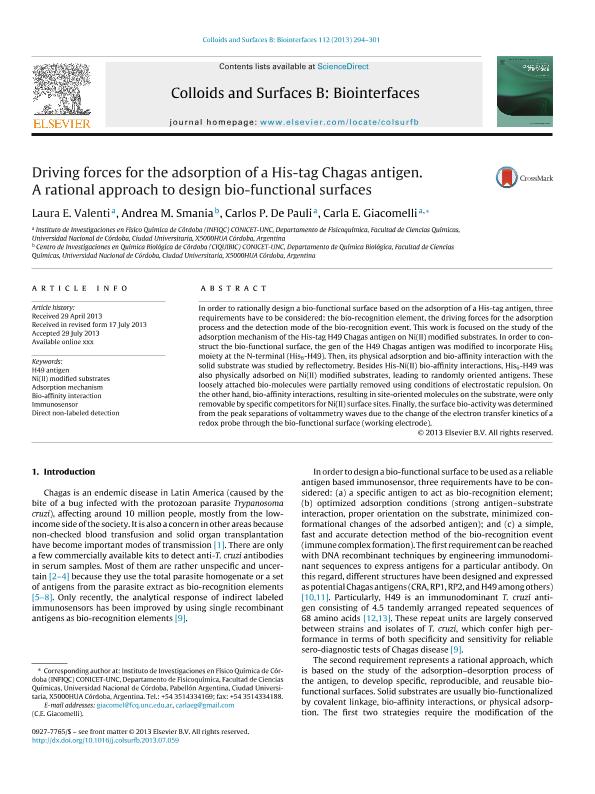Artículo
Driving forces for the adsorption of a His-tag Chagas antigen: a rational approach to design bio-functional surfaces
Fecha de publicación:
08/2013
Editorial:
Elsevier Science
Revista:
Colloids and Surfaces B: Biointerfaces
ISSN:
0927-7765
Idioma:
Inglés
Tipo de recurso:
Artículo publicado
Clasificación temática:
Resumen
In order to rationally design a bio-functional surface based on the adsorption of a His-tag antigen, three requirements have to be considered: the bio-recognition element, the driving forces for the adsorption process and the detection mode of the bio-recognition event. This work is focused on the study of the adsorption mechanism of the His-tag H49 Chagas antigen on Ni(II) modified substrates. In order to construct the bio-functional surface, the gen of the H49 Chagas antigen was modified to incorporate His6 moiety at the N-terminal (His6-H49). Then, its physical adsorption and bio-affinity interaction with the solid substrate was studied by reflectometry. Besides His-Ni(II) bio-affinity interactions, His6-H49 was also physically adsorbed on Ni(II) modified substrates, leading to randomly oriented antigens. These loosely attached bio-molecules were partially removed using conditions of electrostatic repulsion. On the other hand, bio-affinity interactions, resulting in site-oriented molecules on the substrate, were only removable by specific competitors for Ni(II) surface sites. Finally, the surface bio-activity was determined from the peak separations of voltammetry waves due to the change of the electron transfer kinetics of a redox probe through the bio-functional surface (working electrode).
Archivos asociados
Licencia
Identificadores
Colecciones
Articulos(CIQUIBIC)
Articulos de CENTRO DE INVEST.EN QCA.BIOL.DE CORDOBA (P)
Articulos de CENTRO DE INVEST.EN QCA.BIOL.DE CORDOBA (P)
Articulos(INFIQC)
Articulos de INST.DE INVESTIGACIONES EN FISICO- QUIMICA DE CORDOBA
Articulos de INST.DE INVESTIGACIONES EN FISICO- QUIMICA DE CORDOBA
Citación
Valenti, Laura Elisa; Smania, Andrea; de Pauli, Carlos Primo; Giacomelli, Carla Eugenia; Driving forces for the adsorption of a His-tag Chagas antigen: a rational approach to design bio-functional surfaces; Elsevier Science; Colloids and Surfaces B: Biointerfaces; 112; 8-2013; 294-301
Compartir
Altmétricas




